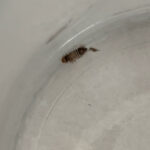Depending on the type, a worm virus can do major damage to you computer. For starters, worms can temporarily paralyze or completely disable entire servers. Some worm viruses can even tunnel into your computer, giving others remote access to your system. A computer worm virus is not unlike a biological virus. It is a self-replicating computer program that spreads by inserting copies of itself into other executable code or documents. The insertion of a computer virus into the program is called an “infection.” The infected file or executable code that is not part of a file is called a “host.” Worm viruses are one of the several different types of malicious software or “malware.”
Worms are a subclass of viruses, but they are different from Trojan horses. Worms can spread from computer to computer, travel across networks, and copy your address book in order to send itself to all of your contacts. “Trojan Horse” is different. A Trojan Horse, or just “Trojan,” will present itself as a helpful program, but once you install it on your computer, it will wreak havoc on your system almost immediately.
A Trojan Horse may appear in the form of a file or software program that has been sent from a legitimate source. The Trojan Horse will install and a number of things can happen. Some Trojans will simply rearrange your desktop or add annoying icons to your desktop and others will delete entire files. Some of the more advanced Trojans can open the door to predators looking to steal your identity. These types of Trojans can give users unlimited access to your system.
One of the most notorious worm viruses ever created is the Blaster Worm. The Blaster Worm, created (in part) by an 18-year-old from Minnesota in 2003, spread on computers running Windows XP and Windows 2000. The worm was also called “Lovsan,” “Lovesan,” MSBlaster. The first version of the Blaster Worm was found on August 11, 2003. Many variants of this worm appeared shortly after. On August 13, 2009 the then 18-year-old Jeffrey Lee Parson released the Blaster B worm from his home in Hopkins, Minnesota. News about the Blaster Worm spread just as fast as the worm itself, so this helped curb the spread as well as filtering ISPs.
On August 19, 2003, federal agents, based on suspicion that he had released a malicious software program, searched Parson’s home. Parson was arrested on August 29, 2003. Nearly a year later, on August 11, 2004, Parson pled guilty. He was sentenced on January 28, 2005 to 18 months in prison.
Trojan and Worm Removal Tools
To get rid of worm viruses, Trojans, or any other malicious software there are a number of free Trojan and worm removal software tool downloads available on the web. It is important to make sure that that the worm removal tool download is from a trusted source. If you are running Windows, stick with Microsoft software downloads. Microsoft offers its “Windows Malicious Software Removal Tool” free of charge for its Windows operating system. The great thing about this free Trojan and worm removal tool is that it updates once a month and reports if malicious software is found.
Other malware and worm removal tools include: Norton AntiVirus and McAfee Antivirus. These software programs are not free. It is important to note that while the Microsoft Software Removal Tool helps remove infections, it does not prevent them. If you want added security, it’s best to install Norton or McAfee as well.
From Microsoft:
The Microsoft Windows Malicious Software Removal Tool checks Windows XP, Windows 2000, and Windows Server 2003 computers for and helps remove infections by specific, prevalent malicious software including Blaster Worm, Sasser, and Mydoom. When the detection and removal process is complete, the tool displays a report describing the outcome, including which, if any, malicious software was detected and removed. The tool creates a log file named mrt.log in the %WINDIR%\debug folder.
Version 1.30 adds Win32/Allaple to the list of malicious software this tool detects.
You can download directly from the Microsoft website or Cnet.com.
All About Worms is always free, always reader-supported. Your tips via CashApp, Venmo, or Paypal are appreciated! Receipts will come from ISIPP Publishing.













